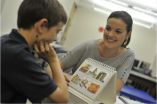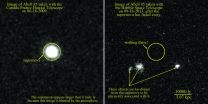Bristol undergraduate identifies Gloucestershire fossil as new species of ancient reptile
2015-06-04
(Press-News.org) Research by Catherine Klein, an undergraduate in Bristol's School of Earth Sciences, shows that fossils from the previously unstudied Woodleaze Quarry belong to a new species of the 'Gloucester lizard' Clevosaurus (named in 1939 after Clevum, the Latin name for Gloucester).
In the Late Triassic, the hills of the South West of the UK formed an archipelago that was inhabited by small dinosaurs and relatives of the Tuatara, a living fossil from New Zealand. The limestone quarries of the region have many caves or fissures containing sediments filled with the bones of abundant small reptile species that give us a unique insight into the animals that scuttled at the feet of the dinosaurs. The fissures are of worldwide importance in yielding such well- preserved small reptiles.
Catherine Klein, who completed the research as part of a summer project, said: "The new species, Clevosaurus sectumsemper, probably lived near the edge of one of the ancient archipelago's islands, in a relatively hostile environment. This would explain why nearly all the bones come from one species, and why there is a relatively high occurrence of healed fractures such as one we found in a rib. Possibly the animals were fighting each other due to a limited food source or perhaps they preyed on each other and bones were broken, but some individuals survived and their broken bones healed."
Like some other clevosaurs, which were found throughout the ancient world, the new species has a self-sharpening dentition: with each bite the teeth are sharpened as they cut past each other very precisely. As a result, old individuals are left with sharp ridges of bone which they use as a cutting surface.
"The species name sectumsemper means 'always cut', and was chosen to reflect this," said Catherine. "It is also a nod to the Harry Potter character Severus Snape, who made a spell called sectumsempra (perhaps meaning sever forever)."
"There were enough differences, particularly in the jaws, to allocate the material to a new species," said Professor Mike Benton, one of Catherine's supervisors.
Another supervisor, Dr David Whiteside, added that the new reptile has a specially adapted dentition that allows it to tackle much larger food than would usually be expected for such a small animal, the smallest of the clevosaurs.
Woodleaze Quarry lies 800m to the south of Tytherington Quarry which produced bones of the Bristol dinosaur Thecodontosaurus.
Dr Whiteside, who originally described the Tytherington fauna, said: "It is remarkable from an ancient geography point of view because we have evidence of a gradual decline in species richness from the northern Tytherington fissures to the almost complete dominance of Clevosaurus sectumsemper in the fauna of Woodleaze in the south as the edge of the ancient island is reached. Perhaps we are documenting the details of geographic distribution at the time."
Catherine, Dr Whiteside and Professor Benton wish to especially thank Hanson Aggregates Ltd. for access and assistance in fieldwork in their quarries.
INFORMATION:
Paper
'A distinctive Late Triassic microvertebrate fissure fauna and a new species of Clevosaurus (Lepidosauria: Rhynchocephalia) from Woodleaze Quarry, Gloucestershire, UK' by Klein et al., in Proceedings of the Geologists' Association
ELSE PRESS RELEASES FROM THIS DATE:
2015-06-04
New research has revealed that parasitic 'vampire' plants that attach onto and derive nutrients from another living plant may benefit the abundance and diversity of surrounding vegetation and animal life.
By altering the densities of the hemiparasite (a parasitic plant that also photosynthesises) Rhinanthus minor, in the Castle Hill National Nature Reserve in Sussex, ecologists from the Universities of York, Sussex and Lincoln were able to assess the impacts of the 'vampire' plants on the biodiversity of a species-rich semi-natural grassland. The scientists compared ...
2015-06-04
NORTH GRAFTON, Mass. (June 4, 2015)--Birds, like people, can suffer from conditions where a blood transfusion is a necessary life-saving measure. But in many instances, unless an avian donor is readily available, accessing blood is impossible because of the challenges associated with storing the species' red blood cells.
New research published in the American Journal of Veterinary Research has found that a substance called dimethyl sulfoxide (DMSO) shows promise as a potential cryopreservant for freezing avian blood.
"Birds are susceptible to various causes of blood ...
2015-06-04
In many animal species, the chromosomes differ between the sexes. The male has a Y chromosome. In some animals, however, for example birds, it is the other way round. In birds, the females have their own sex chromosome, the W chromosome. For the first, researchers in Uppsala have mapped the genetic structure and evolution of the W chromosome.
Every individual of a species has the same sorts of chromosomes, with one exception. In many species, the way the sexes differ is that males have their own sex chromosome, the Y chromosome. This contains genes which result in the ...
2015-06-04
ARLINGTON, Texas -- Toys, appliances, and even a sofa and coffee table can impact the way or when a baby first crawls, walks or achieves other growth milestones, but a new UT Arlington study finds that many parents are unaware of the significant role household items play in their infant's motor skill development.
Priscila Caçola, an assistant professor of kinesiology in the UT Arlington College of Nursing and Health Innovation, co-developed a simple questionnaire for caregivers of infants aged 3 to 18 months that she says can aid in the evaluation of toys and other ...
2015-06-04
From AGU's blogs: Flooding, erosion risks rise as Gulf of Mexico waves loom larger
Waves in the northern Gulf of Mexico are higher than they were 30 years ago, contributing to a greater risk of coastal erosion and flooding in Florida, Alabama, Mississippi and Louisiana, according to a new study in Geophysical Research Letters.
From Eos.org: Building Sandbars in the Grand Canyon
Annual controlled floods from one of America's largest dams are rebuilding the sandbars of the iconic Colorado River, according to a new article by U.S. Geological Survey scientists in Eos. ...
2015-06-04
Sharp images obtained by the Hubble Space Telescope confirm that three supernovae discovered several years ago exploded in the dark emptiness of intergalactic space, having been flung from their home galaxies millions or billions of years earlier.
Most supernovae are found inside galaxies containing hundreds of billions of stars, one of which might explode per century per galaxy.
These lonely supernovae, however, were found between galaxies in three large clusters of several thousand galaxies each. The stars' nearest neighbors were probably 300 light years away, nearly ...
2015-06-04
AURORA, Colo. June 3 -- As America's obesity epidemic continues to grow, a new study from the University of Colorado Anschutz Medical Campus shows that a low-cost, non-profit weight loss program offers the kind of long-term results that often elude dieters.
'We know that people lose weight and then gain it back,' said study author Nia S. Mitchell, M.D., MPH, a researcher with the Division of General Internal Medicine at the Anschutz Health and Wellness Center at CU Anschutz. 'In this case, we found that people who renewed their annual membership in the program lost a ...
2015-06-04
One of the most widely used tools in epigenetics research - the study of how DNA packaging affects gene expression - is chromatin immunoprecipitation (ChIP), a technique that allows researchers to examine interactions between specific proteins and genomic regions. However, ChIP is a relative measurement, and has significant limitations that can lead to errors, poor reproducibility and an inability to be compared between experiments.
To address these issues, scientists from the University of Chicago have developed a new technique that calibrates ChIP experiments with an ...
2015-06-04
About one-third of patients admitted to an intensive care unit (ICU) will develop delirium, a condition that lengthens hospital stays and substantially increases one's risk of dying in the hospital, according to a new study led by Johns Hopkins Medicine researchers appearing in the British Medical Journal.
"Every patient who develops delirium will on average remain in the hospital at least one day longer," says one of the study's authors, Robert Stevens, M.D., a specialist in critical care and an associate professor at the Johns Hopkins University School of Medicine. ...
2015-06-04
[EMBARGOED UNTIL THURSDAY, JUNE 4] Although treatment advances have dramatically reduced deaths from opportunistic infections related to AIDS, a new study drawing on 30 years of data from more than 20,000 patients in San Francisco suggests there is still ample room to improve. About a third--35 percent--of AIDS patients diagnosed with their first opportunistic infection from 1997 to 2012 in that city died within five years, according to the study, published in the Journal of Infectious Diseases.
"While recent research suggests that many opportunistic infections in the ...
LAST 30 PRESS RELEASES:
[Press-News.org] Bristol undergraduate identifies Gloucestershire fossil as new species of ancient reptile

